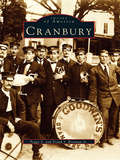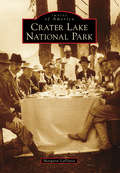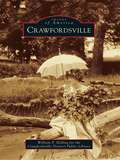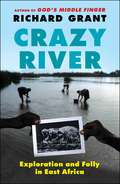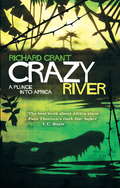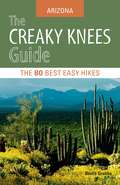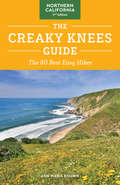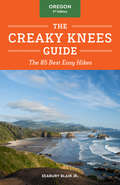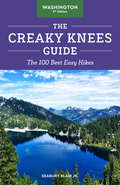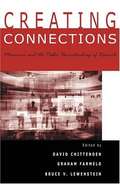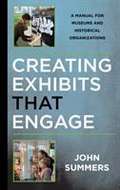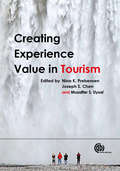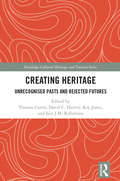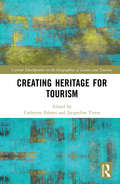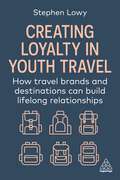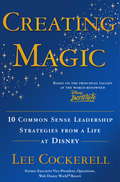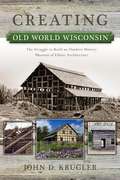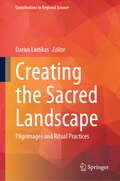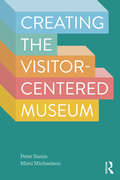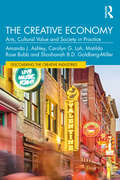- Table View
- List View
Cranbury (Images of America #Vol. 1)
by Peggy S. Brennan Frank J. Brennan Jr.Few New Jersey towns have retained as much nineteenth-century charm as Cranbury. Set in agriculturally rich Middlesex County, Cranbury is known for its shuttered white-clapboard houses, lovely shaded streets, picket fences, and tranquil lake. First settled in 1697, Cranbury came of age more than one hundred years later when it developed into a bustling center with a gristmill, a sawmill, tanneries, blacksmith shops, and other business enterprises typical of small-town America. These images are fascinating: most of them have never before been published, and many of them were donated from family albums and collections. The recollections of many living residents have been included as well, and the stories, anecdotes, and memories breathe life into the images of a by-gone era. The result is a remarkable visual history, both informative and entertaining, that serves to preserve and celebrate Cranbury's proud heritage. Cranbury is a journey into the past that will thrill resident and visitor, young and old alike.
Crap Souvenirs: The Ultimate Kitsch Collection
by Doug LanskyThe Best of the Worst Ah, those tacky trinkets that find their way into our suitcases and our hearts… The Hugo Chavez action figure from a trip to Venezuela. A bikini-clad plastic flamingo commemorating your favorite vacation to Miami Beach. And those Mussolini boxer shorts to memorialize your visit to Italy. Whether you have some of these items scattered on your shelves or you like to poke fun at those who do, this illustrated collection of tacky souvenirs is for anyone who appreciates the finer aspects of off-the-charts kitsch. .
Crater Lake National Park
by Margaret LaplanteFor more than half a million years, volcano Mount Mazama towered over southern Oregon. From time to time, it erupted, spreading pumice, ash, and cinders for miles around. Then, approximately 7,700 years ago, Mount Mazama erupted with such force that the volcano could no longer support itself and it collapsed, leaving a large caldera. Eventually, the volcanic action subsided and all was calm. Over the next centuries, water and snow accumulated in the caldera. In 1902, Crater Lake became a national park.
Crawfordsville (Images of America)
by William P. Helling Crawfordsville District Public LibraryCrawfordsville, founded in the early 1820s, has a diverse history for a small town located in rural, west-central Indiana. The town was the site of an important land office, which attracted many settlers, as well as speculators, to the area. Crawfordsville became known for its intellectual and progressive atmosphere and earned the nickname of the "Athens of Indiana," especially for the numerous residents with literary accomplishments. Wabash College was established in Crawfordsville in 1832, and the institution's teachers and students have contributed greatly to the development of the town's culture and prestige. In addition to its authors and poets, Crawfordsville has had its share of musicians, artists, soldiers, and statesmen who have played a role far beyond the borders of Montgomery County, of which Crawfordsville is the seat. Images of America: Crawfordsville is a photographic tour of the people and places that have marked this town from its early days. Some 200 historical images capture the town's development, along with its interesting, and often unique, accomplishments.
Crazy River: Exploration and Folly in East Africa
by Richard GrantNO ONE TRAVELS QUITE LIKE RICHARD GRANT and, really, no one should. In his last book, the adventure classic God's Middle Finger, he narrowly escaped death in Mexico's lawless Sierra Madre. Now, Grant has plunged with his trademark recklessness, wit, and curiosity into East Africa. Setting out to make the first descent of an unexplored river in Tanzania, he gets waylaid in Zanzibar by thieves, whores, and a charismatic former golf pro before crossing the Indian Ocean in a rickety cargo boat. And then the real adventure begins. Known to local tribes as "the river of bad spirits," the Malagarasi River is a daunting adversary even with a heavily armed Tanzanian crew as travel companions. Dodging bullets, hippos, and crocodiles, Grant finally emerges in war-torn Burundi, where he befriends some ethnic street gangsters and trails a notorious man-eating crocodile known as Gustave. He concludes his journey by interviewing the dictatorial president of Rwanda and visiting the true source of the Nile. Gripping, illuminating, sometimes harrowing, often hilarious, Crazy River is a brilliantly rendered account of a modern-day exploration of Africa, and the unraveling of Grant's peeled, battered mind as he tries to take it all in.
Crazy River: A Plunge into Africa
by Richard GrantNo-one travels like the renowned writer-adventurer Richard Grant and, really, no-one should. Having narrowly escaped death at the hands of Mexican drug barons in Bandit Roads, he now plunges with his trademark recklessness and curiosity into Africa. Setting out to make the first descent of a previously unexplored river in Tanzania, he gets waylaid by thieves, whores and a degenerate former golf pro in Zanzibar, then crosses the Indian Ocean in a cargo dhow before the real adventure begins on the Malagarasi river. Travelling by raft, dodging bullets, hippos, lions and crocodiles, hacking through swamps and succumbing to fevers, Grant's gripping, illuminating and often hilarious book will thrill his devoted readers and bring him to an even broader audience.
Crazy Tales of Blood and Guts
by Teresa Solana Peter BushFascinating short stories that include a rather bloody satire on installation art, including the Edgar Award-nominated story "Still Life No.41", a wonderful story of gruesome revenge involving a wayward son-in-law, a surprising and hilarious tale of a pre-historic serial killer who invents God and psychoanalysis, and, inevitably, a vampire story told with venom and humor.These stories remind one of the best short stories by Stephen King, such as those in the 'Just after Sunset' compilation. They can be horrific but are never without a devastating sense of humor. As in the adult short stories of Roald Dahl (the 'Kiss Kiss' collection in particular, with its tales of family and other violence) there is great ingenuity, surprising and satisfying endings, and, since it's Solana, deep cutting satire of contemporary fads and mores.
The Creaky Knees Guide Arizona: The 80 Best Easy Hikes (Creaky Knees)
by Bruce GrubbsThe Creaky Knees Guide Arizona is a hiking guidebook filled with kinder, gentler trails. Created for anyone who--regardless of age--can't or doesn't want to hike great distances over rough terrain to gain beautiful vistas and enjoy the wilderness. Here are 80 of the best easy-to-walk hikes throughout the state. Most are day hikes, but there are a handful of backpack trips worthy of the Creaky Knees stamp of approval.Trails are divided into regions: Grand Canyon, Northeast Plateaus, San Francisco Peaks Area, Mogollon Rim Country, Central Highlands, White Mountains, Phoenix Area, Tucson Area, Southern Mountains, and Western Deserts.In addition to a full-trip description, each hike includes: Elevation gains, including a topographical map. Clear, up-to-date driving directions. Mileage and estimated hiking time, trail conditions, effort level, best season, map references, exploring options, access, permits required, and where to find more information. Further directions to offshoot hikes, if you reach the end of the hike, but want to extend your workout.A chart at the front of the book compiles the hikes per effort level required, overall hike rating, and best season(s) to hit the trails.Written in a personal but informative tone by outdoors expert Bruce Grubbs, this Creaky Knees guidebook is a perfect resource anyone can use to explore the beauty of Arizona, without breaking too much of a sweat.
The Creaky Knees Guide Northern California, 2nd Edition: The 80 Best Easy Hikes (Creaky Knees)
by Ann Marie BrownThis fully updated edition of this bestselling easy hiking guide (over 10,000 sold) features the 80 best low-impact day hikes in Northern California, perfect for aging baby boomers, seniors, those traveling with small children, and anyone else interested more in a stroll than a climb.From hikes just outside of San Francisco to long strolls in the Sierra Nevada, this book covers 80 of the best easy-to-walk hikes throughout the region, providing elevation gains, detailed maps, and up-to-date driving directions. It also includes hike mileage and estimated hiking times, trail conditions, access and permit requirements, and ratings of each hike's difficulty, from "Stroll in the Park" to "Prepare to Perspire." Offshoot hikes are featured for those who reach the end of the hike but want to extend their workout. Written in a personal but informative tone by outdoors expert Ann Marie Brown, the Creaky Knees Guide is a perfect resource anyone can use to explore the beauty of Northern California without breaking too much of a sweat.
The Creaky Knees Guide Oregon, 3rd Edition: The 85 Best Easy Hikes (Creaky Knees)
by Seabury BlairThe updated edition of this bestselling guide (25,000 copies sold) features 85 of the best low-impact day hikes in Oregon state, perfect for aging baby boomers, seniors, those traveling with small children, and anyone else interested more in a stroll than a climb.The Creaky Knees Guide Oregon is a day-hiking guidebook filled with kinder, gentler trails, featuring the best easy-to-walk hikes throughout the state. Written in an informative style that will appeal to anyone, regardless of age, the guide covers hikes in six regions throughout the state, including the Oregon Coast, Columbia River Gorge, and Mount Hood. There is also a section on urban hikes and walks. Each trail description includes elevation gains, including a topographical map; clear, up-to-date driving directions; mileage and estimated hiking time; trail conditions; and more.This guide by Day Hike! series author Seabury Blair Jr. is a perfect resource anyone can use to explore the beauty of the Northwest, without breaking too much of a sweat.
The Creaky Knees Guide Washington, 3rd Edition: The 100 Best Easy Hikes (Creaky Knees)
by Seabury BlairThe updated edition of this bestselling guide (25,000 copies sold) features 85 of the best low-impact day hikes in Oregon state, perfect for aging baby boomers, seniors, those traveling with small children, and anyone else interested more in a stroll than a climb.The Creaky Knees Guide Oregon is a day-hiking guidebook filled with kinder, gentler trails, featuring the best easy-to-walk hikes throughout the state. Written in an informative style that will appeal to anyone, regardless of age, the guide covers hikes in six regions throughout the state, including the Oregon Coast, Columbia River Gorge, and Mount Hood. There is also a section on urban hikes and walks. Each trail description includes elevation gains, including a topographical map; clear, up-to-date driving directions; mileage and estimated hiking time; trail conditions; and more.This guide by Day Hike! series author Seabury Blair Jr. is a perfect resource anyone can use to explore the beauty of the Northwest, without breaking too much of a sweat.
Creaky Traveler in the North West Highlands of Scotland
by Warren RovetchOn a journey of discovery, Warren and Gerda Rovetch, both "creaky" themselves, explore the hidden places of Great Britain's last wilderness, the rugged and startling coast of Scotland's North West Highlands. They bring fresh perspectives to the environmental, cultural, and spiritual dimensions of their experience as their journey moves at an easy pace from village pubs and croft houses to places of untouched natural beauty and solitude. Celtic history and tradition comes alive as our hosts meander their way along. Part travelogue, part guidebook, but all charm and wit, this book transports us to another culture where we have much to learn.
Creating Connections: Museums and the Public Understanding of Current Research
by Bruce Lewenstein David Chittenden Graham FarmeloThis fundamentally human need to find out about the world led to the creation of this book.
Creating Exhibits That Engage: A Manual For Museums And Historical Organizations (American Association For State And Local History)
by John SummersCreating Exhibits that Engage: A Manual for Museums and Historical Organizations is a concise, useful guide to developing effective and memorable museum exhibits. The book is full of information, guidelines, tips, and concrete examples drawn from the author’s years of experience as a curator and exhibit developer in the United States and Canada. Is this your first exhibit project? You will find step-by-step instructions, useful advice and plenty of examples. Are you a small museum or local historical society looking to improve your exhibits? <p><p> This book will take you through how to define your audience, develop a big idea, write the text, manage the budget, design the graphics, arrange the gallery, select artifacts, and fabricate, install and evaluate the exhibit. Are you a museum studies student wanting to learn about the theory and practice of exhibit development? This book combines both and includes references to works by noted authors in the field. Written in a clear and accessible style, Creating Exhibits that Engage offers checklists of key points at the end of each chapter, a glossary of specialized terms, and photographs, drawings and charts illustrating key concepts and techniques.
Creating Experience Value in Tourism
by Professor Levent Altinay Lidia Andrades Caldito Peter Björk Prakash Chathoth Tove I. Dahl Frederic Dimanche Tor Korneliussen Young-Souk Lee Vincent Magnini Line Mathisen Lena Mossberg Bruce Prideaux Haywantee Ramkissoon M. Joseph Sirgy Xiaojuan Yu Dr Eric Chan Dr Dong-Jin Lee Dr Grace B Yu Dr Monica Hanefors Ann Heidi Hansen Dr Robert Harrington Dr Fevzi Okumus Kay Roach Professor Zvi Schwartz Dr Gerardo R UngsonResearch delivers a multitude of approaches to value creation, represented here as a set of definitions, perspectives and interpretations of how tourists, as customers, create value alone and with others. Now updated throughout, Creating Experience Value in Tourism, 2nd Edition provides a clarification of these approaches as well as a practical translation as to how they can work within industry. Including a framework to distinguish among key resources or antecedents of customer value, this new edition: - Introduces the concept of co-creation of value in the tourist experience, looking at the definitions, structures and models available; - Provides a new chapter addressing value creation and resource configuration; - Considers consumer behaviour and factors affecting value creation from both physiological and psychological perspectives; - Introduces a new full colour internal design to aid understanding. Concluding with a summary of the areas for future research, this is a key resource for researchers, particularly those interested in experience value and co-creation, as well as a useful read for students of tourism and related industries.
Creating Experience Value in Tourism
by Vincent Magnini Ossi Pesämaa Nina K Prebensen Peter Björk Young-Souk Lee Line Mathisen Muzaffer Uysal Haywantee Ramkissoon M. Joseph Sirgy Joseph S Chen Graham Dann Tor Korneliussen Lena Mossberg Øystein Jensen Akan Yanik Lidia Andrades Caldito Bruce Prideaux Xiaojuan Yu Tove I. Dahl Prakash ChathothAs the field of tourism grows in maturity and scientific sophistication, it is important to fully understand the breadth and depth of vacation experience value. Current research delivers a multitude of approaches to value creation, represented here as a set of definitions, perspectives, and interpretations of how tourists, as customers, create value alone and with others. Providing an analytical and systematic clarification of the approaches, this book suggests an understanding of the differences, offering new and practical knowledge for tourism scholars and professionals to highlight the relevance of the concept to firms and organizations. Including a framework to distinguish among key resources or antecedents of customer value, this book also considers consumer behaviour and factors affecting value creation from physiological and psychological perspectives. Concluding with a summary of the areas for future research, it is a valuable resource for researchers of tourism, leisure and recreation.
Creating Experience Value in Tourism
by Nina K Prebensen Professor Joseph S Chen Muzaffer Uysal Professor Levent Altinay Lidia Andrades Caldito Peter Björk Prakash Chathoth Tove I. Dahl Frederic Dimanche Tor Korneliussen Young-Souk Lee Vincent Magnini Line Mathisen Lena Mossberg Bruce Prideaux Haywantee Ramkissoon M. Joseph Sirgy Xiaojuan Yu Dr Eric Chan Dr Dong-Jin Lee Dr Grace B Yu Dr Monica Hanefors Ann Heidi Hansen Dr Robert Harrington Dr Fevzi Okumus Kay Roach Professor Zvi Schwartz Dr Gerardo R UngsonResearch delivers a multitude of approaches to value creation, represented here as a set of definitions, perspectives and interpretations of how tourists, as customers, create value alone and with others. Now updated throughout, Creating Experience Value in Tourism, 2nd Edition provides a clarification of these approaches as well as a practical translation as to how they can work within industry. Including a framework to distinguish among key resources or antecedents of customer value, this new edition: - Introduces the concept of co-creation of value in the tourist experience, looking at the definitions, structures and models available; - Provides a new chapter addressing value creation and resource configuration; - Considers consumer behaviour and factors affecting value creation from both physiological and psychological perspectives; - Introduces a new full colour internal design to aid understanding. Concluding with a summary of the areas for future research, this is a key resource for researchers, particularly those interested in experience value and co-creation, as well as a useful read for students of tourism and related industries.
Creating Heritage: Unrecognised Pasts and Rejected Futures (Routledge Cultural Heritage and Tourism Series)
by Thomas Carter David Charles Harvey Roy Jones Iain RobertsonThis book investigates the selection process of heritagisation to understand what specific pasts are being selected or rejected for representation, who is selecting them, how and to whom they are being represented and why they are being presented, or dismissed, in the ways that they are. Some aspects of our pasts are venerated and memorialised for a variety of reasons, while others are forgotten or even hidden. This volume, thus, provides examples from across a spectrum. Some phenomena are well-suited to heritagisation, such as animals memorialised for their bravery, long past agricultural techniques and implements, and impressive landscapes. However, this book also deals with products (e.g. tobacco), historical periods (e.g. the Third Reich) and scientific techniques (e.g. genetic modification) with negative connotations that extend beyond their heritage attributes. This volume considers how the actors in the heritage industry admit, valorise, prioritise and rationalise historic resources as heritage products. These findings provide practical examples of how heritage institutions privilege, frame and/or exclude a wide range of heritage items. They also contrast the invocations of sectional (local, national or class based) and more cosmopolitan heritages and consider the extent to which innovation and change are or can be acknowledged within the heritage discourse.
Creating Heritage for Tourism (Current Developments in the Geographies of Leisure and Tourism)
by Catherine Palmer Jacqueline TiversWhat does ‘heritage’ mean in the twenty-first century? Traditional ideas of heritage involve places where objects, landscapes, people and ideas are venerated and reproduced over time as an inheritance for future generations. To speak of heritage is to speak of a relationship between the past, the present and the future. However, it is a past recreated for economic gain, hence sectors such as culinary tourism, ecotourism, cultural tourism and film tourism have employed the heritage label to attract visitors. This interdisciplinary book furthers understanding on how heritage is socially constructed, interpreted and experienced within different geographic and cultural contexts, in both Western and non-Western settings. Subjects discussed include Welsh linguistic heritage, tango, mushroom tourism, Turkish coffee, literary tourism and the techniques employed to construct tourist accommodation. By focusing upon heritage creation in the context of tourism, the book moves beyond traditional debates about ‘authentic heritage’ to focus on how something becomes heritage for use in the present. This timely volume will be of interest to students and researchers in tourism, heritage studies, geography, museum studies and cultural studies.
Creating Loyalty in Youth Travel: How Travel Brands and Destinations Can Build Lifelong Relationships
by Stephen LowyBy attracting young people, travel brands and destinations can create a lifetime of value, with young people often staying longer, spreading their spend across a destination, contributing to the local economy and returning again and again. Creating Loyalty in Youth Travel explores the varying and unique needs of young tourists - from backpackers to youth mobility workers - and the challenges brands and destinations face in attracting and retaining them. While travel professionals often target certain sectors such as business or luxury travellers, this can be a short-sighted strategy. Youth travellers can be a more sustainable market as they frequently form an emotional tie to a destination or travel brand, driving them to return throughout their lives, sharing with family and friends and increasing their spend as they age. This book looks at how successful brands and destinations prioritize developing long-term relationships with travellers early on, so that they can continue to cater to loyal customers throughout their lives with different offerings from within the same brand. Some countries and travel brands excel at this, building it into the heart of their strategy, while others have ignored this key market to their own detriment. Through extended interviews from leaders in the sector such as Marriott and Tourism Australia, this book helps tourism and hospitality professionals to understand the needs of the youth traveler market and harness the potential of it to build a long-term strategy for the tourism industry.
Creating Magic: 10 Common Sense Leadership Strategies from a Life at Disney
by Lee CockerellThe secret for creating “magic” in our careers, our organizations, and our lives is simple: outstanding leadership—the kind that inspires employees, delights customers, and achieves extraordinary business results. No one knows more about this kind of leadership than Lee Cockerell, the man who ran Walt Disney World® Resort operations for over a decade. And in Creating Magic, he shares the leadership principles that not only guided his own journey from a poor farm boy in Oklahoma to the head of operations for a multibillion dollar enterprise, but that also soon came to form the cultural bedrock of the world’s number one vacation destination. But as Lee demonstrates, great leadership isn’t about mastering impossibly complex management theories. We can all become outstanding leaders by following the ten practical, common sense strategies outlined in this remarkable book. As straightforward as they are profound, these leadership lessons include:- Everyone is important.- Make your people your brand. - Burn the free fuel: appreciation, recognition, and encouragement. - Give people a purpose, not just a job.Combining surprising business wisdom with insightful and entertaining stories from Lee’s four decades on the front lines of some of the world’s best-run companies, Creating Magic shows all of us—from small business owners to managers at every level—how to become better leaders by infusing quality, character, courage, enthusiasm, and integrity into our workplace and into our lives.“It’s not the magic that makes it work; it’s the way we work that makes it magic.”
Creating Old World Wisconsin
by John D. KruglerWith its charming heirloom gardens, historic livestock breeds, and faithfully recreated farmsteads and villages that span nearly 600 acres, Old World Wisconsin is the largest outdoor museum of rural life in the United States. But this seemingly time-frozen landscape of rustic outbuildings and rolling wooded hills did not effortlessly spring into existence, as John D. Krugler shows in Creating Old World Wisconsin. As dozens of historic buildings were transported in the 1970s from various locations throughout the state to the Kettle Moraine State Forest, researchers, curators, and volunteers launched a massive preservation initiative to salvage fast-disappearing immigrant and migrant architecture. They created a backdrop against which twenty-first-century interpreters demonstrate nineteenth- and early twentieth-century agricultural techniques and artisanal craftsmanship. The site, created and maintained by the Wisconsin Historical Society, offers visitors a unique opportunity to learn about the states rich and ethnically diverse past through depictions of the everyday lives of its Norwegian, Danish, Finnish, German, Polish, African American, and Yankee inhabitants. Creating Old World Wisconsin chronicles the fascinating and complex origins of this outdoor museum, highlighting the struggles that faced its creators as they worked to achieve their vision. Even as Milwaukee architect and preservationist Richard W. E. Perrin, the Societys staff, and enthusiastic volunteers opened the museum in time for the national bicentennial in 1976, the site was plagued by limited funds, bureaucratic tangles, and problems associated with gaining public support. By documenting the engaging story of the challenges, roadblocks, false starts, and achievements of the sites founders, Krugler brings to life the history of the dedicated corps who collected and preserved Wisconsins diverse social history and heritage.
Creating the Sacred Landscape: Pilgrimages and Ritual Practices (Contributions to Regional Science)
by Darius LiutikasThis book explores the enduring significance of sacred landscapes in an increasingly globalized world, with a particular focus on the Christian sacred landscape and its connection to pilgrimage and rituals. Drawing on the latest research, it examines the interplay between global societal changes and historical traditions, offering a rich analysis of how sacred spaces shape and reflect cultural and social identities. Through a multidisciplinary lens encompassing cultural geography, anthropology, sociology of tourism, and religious geography, the book illuminates the role of pilgrimage in fostering community identity and preserving historical continuity. By comparing sacred sites and practices across diverse cultural contexts, it provides readers with a deeper understanding of their universal and localized meanings. This work also offers a comprehensive historical perspective, tracing the evolution of sacred landscapes over time and across regions. Accessible and thought-provoking, it invites readers from various disciplines to engage with the cultural, social, and spiritual dimensions of these powerful spaces.
Creating the Visitor-Centered Museum
by Peter Samis Mimi MichaelsonWhat does the transformation to a visitor-centered approach do for a museum? How are museums made relevant to a broad range of visitors of varying ages, identities, and social classes? Does appealing to a larger audience force museums to "dumb down" their work? What internal changes are required? Based on a multi-year Kress Foundation-sponsored study of 20 innovative American and European collections-based museums recognized by their peers to be visitor-centered, Peter Samis and Mimi Michaelson answer these key questions for the field. The book describes key institutions that have opened the doors to a wider range of visitors; addresses the internal struggles to reorganize and democratize these institutions; uses case studies, interviews of key personnel, Key Takeaways, and additional resources to help museum professionals implement a visitor-centered approach in collections-based institutions
The Creative Economy: Arts, Cultural Value and Society in Practice (Discovering the Creative Industries)
by Amanda J. Ashley Carolyn G. Loh Matilda Rose Bubb Shoshanah B.D. Goldberg-MillerThe creative economy permeates our everyday lives, shaping where we live, what we buy, and how we interact with others. Looking at dimensions of people, place, policy, and market forces, the book offers a comprehensive perspective on arts and culture, in both economic and social life.The book explores the multifaceted components that make up this complex field. Underlying this journey is the throughline of diversity, equity, and inclusion as watchwords of today’s global paradigm. Capital, gentrification, pay disparities, and the hegemonic confines of cultural production are a few of the key issues analyzed. Using case studies and stories of artists and creatives from the worlds of fashion, design, music, and the media arts, the book also delves into gastronomy, literature, architecture, and theatre—presenting a nuanced look at the ways in which the creative sector impacts the world today. Readers will benefit from features such as key takeaways, discussion questions, and activities, throughout the chapters.Students, scholars, policymakers, and the general public will find this a valuable resource. This book offers the reader a chance not only to understand the cultural and creative industries, but to internalize its elements and embrace the creative spirit that imbues the sector.
